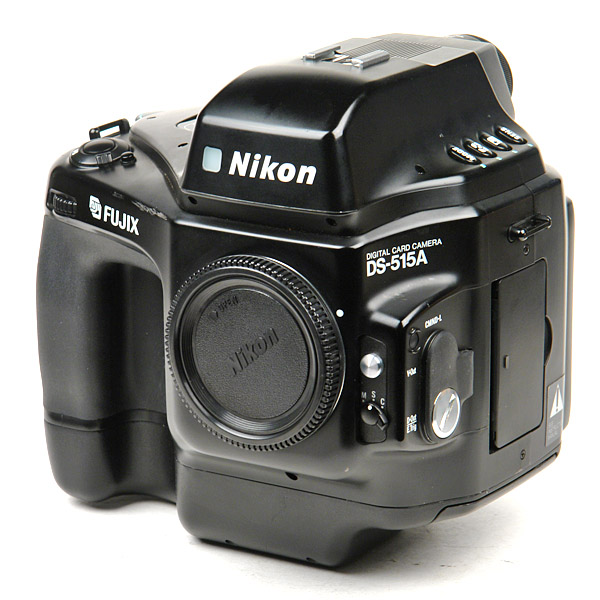This is an adapted article from my Chinese based blog published on August 5, 2013 and updated in September 15, 2013. In fact, the complete version was a charpetr of my DSLR book. To save my time to post this article, I used Google translate to translate the original Chinese version to English. Because Google translate can be FUNNY sometimes, I have to modified the Google version a little bit.
First Digital Camera (1975)
In 1969 , scientists Willard Boyle and George E. Smith of AT &T Bell Labs ( Bell Lab ) invented the CCD ( Charge-Coupled Device ) photosensitive element widely used in today's digital cameras. Two years later ( 1971 ), Bell Labs scientists MF Tompsett , GF Amelio , WJ Bertram Jr. , RR Buckley , WJ McNamara , JC Mikkelsen Jr and DA Sealer recorded black and white images with CCD for the first time. Four years later ( 1975 ) , Steven Sasson , an engineer at Kodak , built the first digital camera that could record black and white images with a resolution of 100x100 (pictured below), enabling. This system used cassette tapes to store images. At that time, there were no CDs and memory cards, and the floppy disk specifications were the 8 -inch version that was nearing its end of life span , the 5 -inch version was yet to be popularized, and the 3.5 -inch version had not yet appeared, so it was a reasonable choice to use cassette tapes. The speed of the tape is quite slow. It takes 23 seconds for the camera to record the image and completely store the image on the cassette tape . The whole system weighs 3.6 kg. Then, Bryce Bayer of Kodak obtained a patent for recording color images in 1976 , and most digital cameras currently use Bayer 's technology. Steven Sasson received the National Medal of Technology and Innovation from President Obama on November 17 , 2009 .
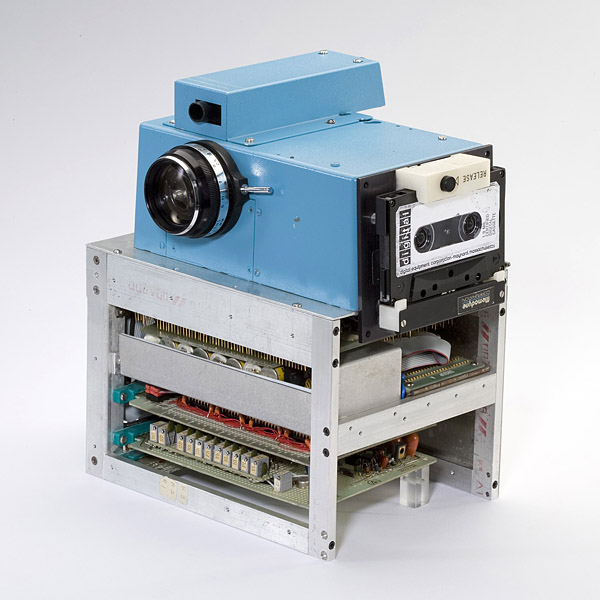
Single-frame Video ( SV) cameras ( 1980s)
Although digital cameras had been used in astronomy, space, national defense, and scientific research for a long time, the development of consumer products was quite slow. The first one to try to enter the market was the Sony Mavica in 1981 ( **MA** gnetic **VI**deo **CA**mera , which had nothing to do with the later Mavica models), but this was a model that recorded analog TV signals, not strictly a digital camera . It is natural for the Sony Mavica to use television technology, since television cameras already used CCD technology in the 1980s . This type of camera records a single frame of television video and stores it on a 2 -inch floppy disk, usually one frame per track. When playing on a TV, the effect of a static image is obtained by repeatedly reading and playing the same picture. Therefore, this model is called a **S**till **V**ideo Camera (or SV camera), that is, a still (single frame) video camera, and electronic cameras in the 1980s are all of this design . This Sony Mavica is just a prototype and not actually produced: the first picture below is the Mavica and 2- inch floppy disk in the display case, and the second is Mavica and its three lenses.
The following images of the Sony MAVIC SV were taken from the web:
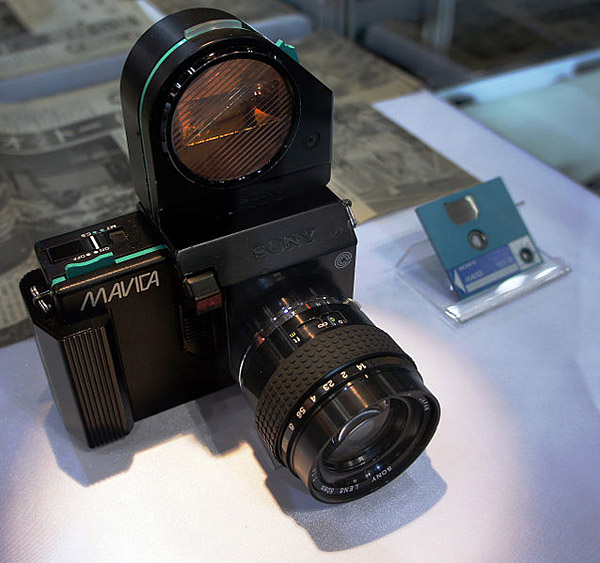
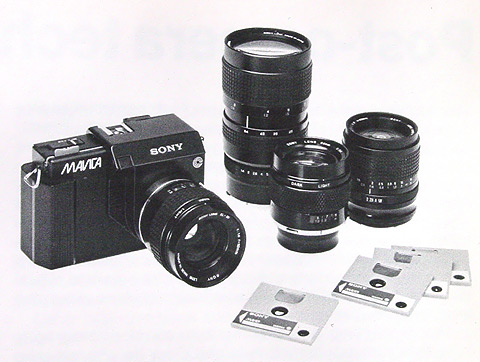
The next milestone came in 1984 in Los Angeles, USA. Canon released a prototype before the Olympics, let reporters try it out during the Olympics, and the photos taken were sent back to Japan with telephone lines and published by the Yomiuri Shimbun. This was the first electronic camera that was actually used in the history of cameras, but it still Is recording TV analog images. Two years later ( 1986 ), both Canon and Sony launched the single-frame video model Still Video SLR , hereinafter referred to as SV SLR , the earlier Canon model was Canon RC-701 ( RC stands for **R**ealtime **C**amera ), and later Sony Mavica MVC-A7AF and Sony Mavica MVC-2000 .
Canon RC-701 (see first photo below) is a modified version of the 1984 prototype, it has a mirror, uses 2/3 inch CCD ( 8.8x6.6mm , crop factor is 3.93 relative to 135 film ), The horizontal resolution is 780 pixels (this is roughly the resolution of a TV 320x300 ), and the images are stored on a 2- inch floppy disk. Canon RC-701 has three lenses: 11-66mm f/1.2 (equivalent to 43-260mm of 135 film , the same below), 50-150mm f/2.8 ( 195-585mm ), and 6mm f/1.8 ( 24mm ). This is just the camera part, the complete system also includes video projector, printer, film laminating machine, and telephone transmitter. Most of the SV models at that time and in the next few years had a video recorder, which was convenient for playing the images on the floppy disk on the TV, or converting the TV analog numbers into digital numbers for storage. Since then, Canon has also releasedCanon RC-760 ( 1987 , SV SLR ) and several non- SLR models, second photo below is Canon RC-470 ( 1988 ). Since 1986 , Japanese manufacturers have launched several SV models one after another, but the output is not large, and most SV cameras are almost outdated as soon as they go on the market, because Kodak has already produced the familiar DSLR in 1987 , but this Model cameras were sold to the US government and were not marketed (see discussion in the next section).
The image below is a Canon RC-701 (1986) and a Canon RC-470 (1988):
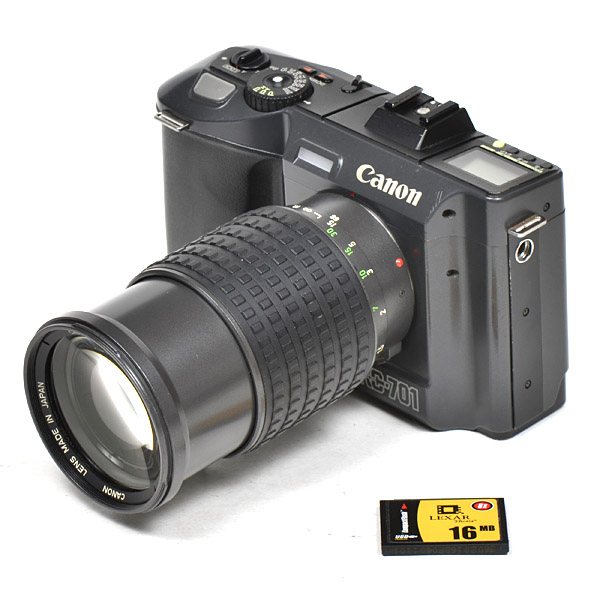
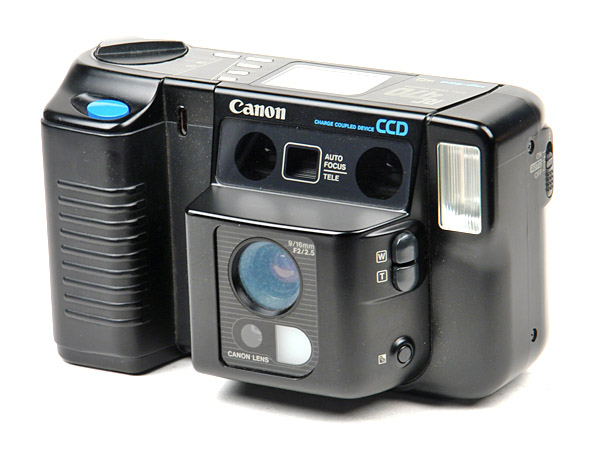
As mentioned earlier, Sony also launched the Sony Mavica MVC-A7AF in 1986. It is an SV SLR with a 2/3 -inch CCD . The lens is a 12-72mm f /1.4 ( 47 -283mm ), it can focus manually or automatically, and the user can add voice instructions to the photos. Sony also released the Sony Mavica MVC-2000 later in the same year , which has a few differences from the MVC-A7AF (for example, there is no audio description function but the HI BAND function is added ). There is a saying that the MVC- 2000 uses a 13X zoom ratio that cannot be replaced , but after looking at a lot of MVC -2000 real machines and photos, the lenses are all 12-72mm , which is 6X rather than13X , this needs to be further verified. The first photo below is of the Sony Mavica MVC-A7AF and the second is its lens.
The next two images show the Sony MVC-A7AF (1986) and the lens on a MVC-A7AF (1986):
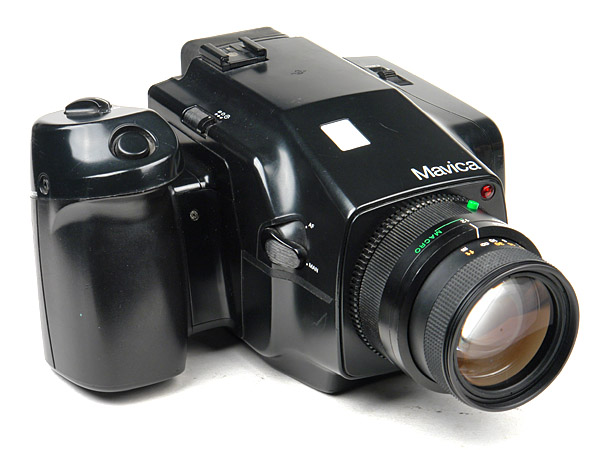
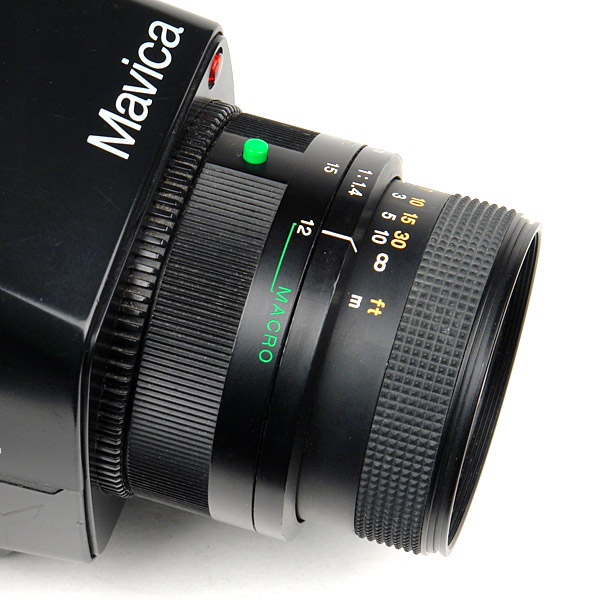
The Sony MVC-A7AF and MVC-2000 did not have much success, but the Mavica MVC-5000, launched in 1989 , became famous because of the Tiananmen incident. When the Tiananmen incident happened, CNN published a photo taken by reporter John Schaer of a young man stopping a tank. At that time, it was said that the photo was shot with a Sony Mavica MVC-5000 , making it a hit. Later, after verification, reporter John Schaer personally said that he used Sony BVU 330 to record the video, and then used Sony ’s digital video transmitter to capture some of the recorded images and transmit them back to the US headquarters in real time through the telephone line. The video part was taken back to the United States by tourists. Even so, many people (perhaps unaware of the truth) still believe, and continue to circulate, that the photo was taken with a Sony Mavica MVC-5000 .
Below is a photo of the Sony Mavica MVC-5000 , an SLR with interchangeable lenses , the adapter is similar to but not the same as the Canon EOS because the EOS lens cannot be mounted on the body and is almost impossible to focus; Sony also produces aMCL-200N mount for Nikon lenses . The Mavica MVC-5000 has two 2/3 -inch CCDs , one records brightness and the other records color, with a total of 720K pixels. Sony 's manual states that the Mavica MVC-5000 has three manual lenses: MCL-05H Wide 5 mm , MCL-06T Wide 6.5mm , and MCL-913T 9.5-123.5mm f/1.8 (this is the lens in the photo); the third 9.5-123.5mm is made by Canon , but I don’t know if the first two are also Canon products. Because the size of the 2/3 inch wafer is 8.8x6.6mm and the diagonal length is 11mm , the crop factor of Sony Mavica MVC-5000 relative to FF is 3.93 ( =43.3/11 ), so the above 5mm , 6.5mm and 9.5-123.5mm are respectively equivalent to 20mm ( =5x3.93 ), 26mm ( =6.5x3.93 ) and 37-485mm of 135 film .
The following is a Sony Mavica MVC-5000 (1989):
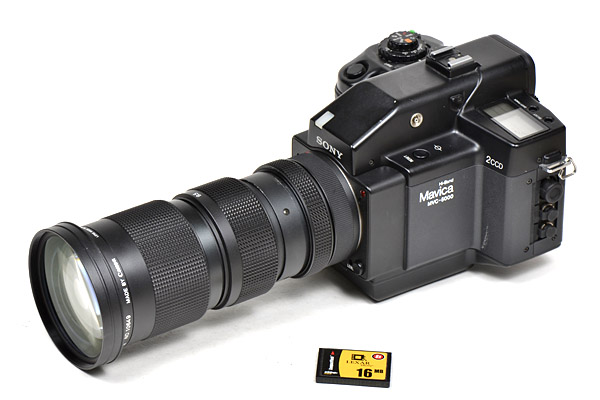
In the professional market, the Sony Mavica MVC-5000 is considered a very successful model, although the sales volume is not large (because it is only sold to professionals). Sony launched the Sony Mavica MVC-7000 in 1992 , but this is the end of the SV model, because the real DSLR was produced in the Kodak laboratory and sold to the US government, and Kodak also launched the Nikon F3 in 1991 . The Kodak DCS on the fuselage officially announces the arrival of the digital generation.
Nikon entered the SV field later than Sony and Canon . It was not until 1986 that the prototype Nikon Still Video Camera Model I ( SVC ) was launched, but it was not produced. This is a SV -style SLR using a 2/3 -inch 300,000 -pixel CCD and a 2- inch floppy disk . It has two lenses : 6mm f/1.6 and 10-40mm f/1.4 . Nikon launched the SV model Nikon QV-1000C in 1988 , which still uses a 2/3 -inch CCD with a resolution of 380K and an available ISO of 400, 800 and 1600 , and equipped with two lenses 10-40mm f/1.4 and 11-120mm f/2 , the images are stored in a 2 -inch floppy disk, but only black and white images are recorded. The production of Nikon QV-1000C is very small, and most of them are used for testing and evaluation by the press. Associated Press reporter Ron Edmonds once used it to shoot the 1989 US Presidential Inauguration.
The following image is a Nikon QV-1000C (1988) and is used with permission from Mr. Jarle Aasland
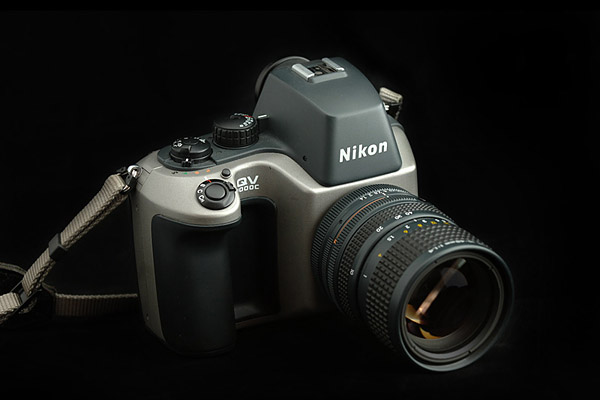
From the 1980s to the early 1990s , in addition to Canon , Nikon and Sony products , other manufacturers showed prototypes and produced a small number of products . They are all SV models , but it is not known whether they are SLRs . What is certain is that the main target of these products is the press rather than general use, because the output is not large (it is said that the production of Nikon QV-1000C is less than 200 units) and the price is extremely high. Since the early 1990s , various companies have launched digital models one after another, so the development of SV models ended in the 1990s .
Kodak's achievements
Kodak produced the first photosensitive chip in history to exceed 1 MP (actually 1.4 MP ) in 1986 , and the US government ordered cameras using it the following year ( 1987 ) . Kodak engineers installed the photosensitive chip on the back of the Canon New F-1 (the first photo below), and put the other parts in a box. The box and the back of the machine were connected with a cable (the second photo). The photos were stored on 8mm tape inside the box , and the images were then read with other equipment (third photo). This camera is called Electro-Optic Camera , it is of course an SLR , and it is the first D SLR in history . The fourth photo is the result of scanning the 8x10 photo taken by the Electro-Optic Camera (the original photo is a bit damaged), and the original author is Mr. James McGarvey , the chief engineer who designed the Electro-Optic Camera .
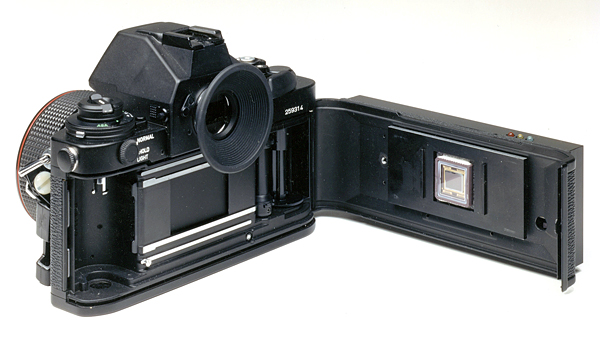
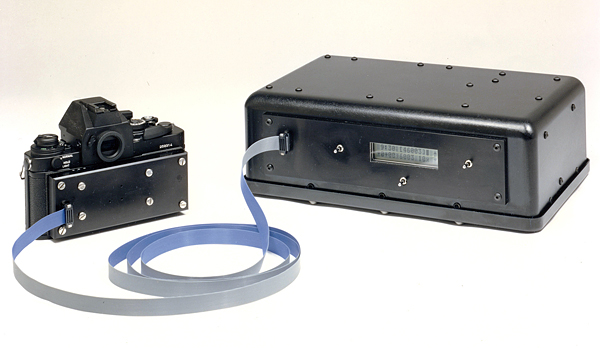
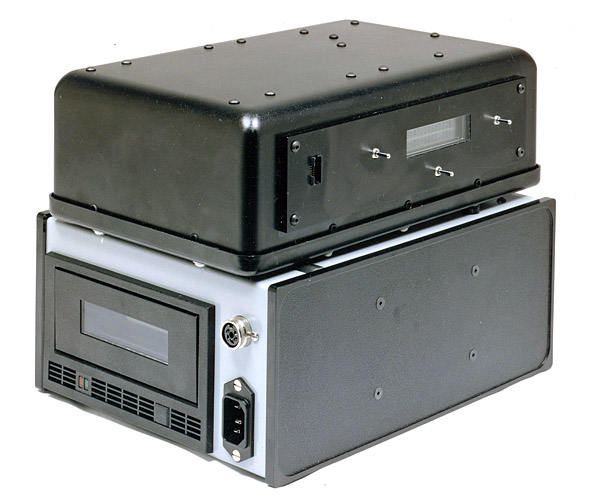
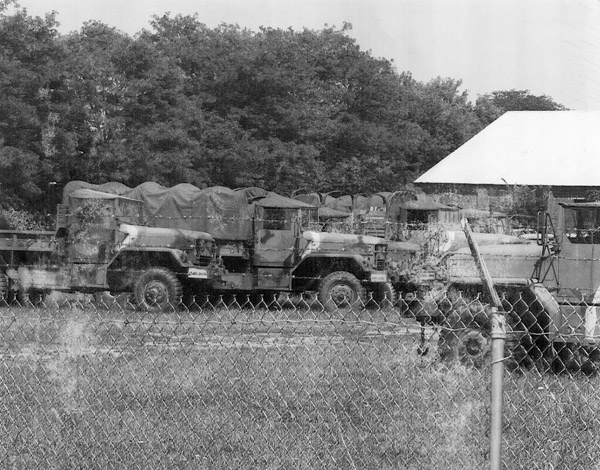
In the development plan of Electro-Optic Camera in 1987 , Mr. Ken Cupery was the project manager of Electro-Optic Camera , Mr. James McGarvey was the chief engineer, responsible for the camera design part, Mr. Bill Toohey designed the analog circuit of CCD , and Mr. Tom McCarthy assembled the whole system. The fourth photo above is a test photo of Mr. McGarvey .
After the Electro-Optic Camera was delivered in 1988 , Kodak engineers used Canon New F-1 body to recreate two DSLRs for display , called Tactical Camera . In March 1989 , the Nikon F3 body was used to create the Hawkeye II (pictured below). The part other than the photosensitive chip is installed in the Nikon F3 film winding motor ( Hawkeye II has no automatic film loading function), and the resolution is 1280x1024 .
The three images are the Kodak Hawkeye II (1989)
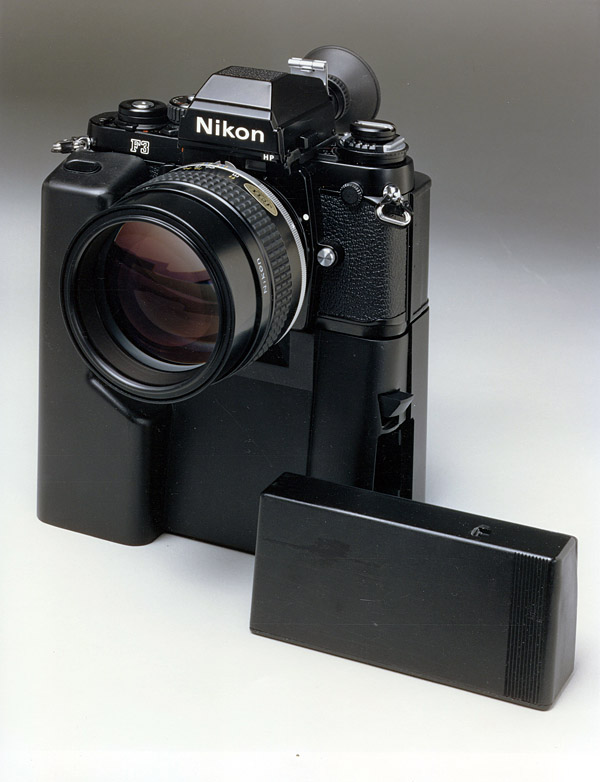
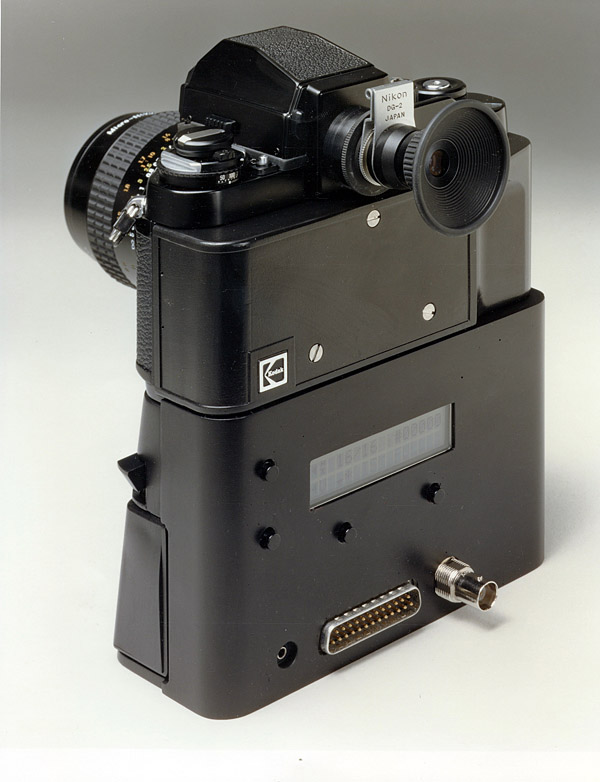
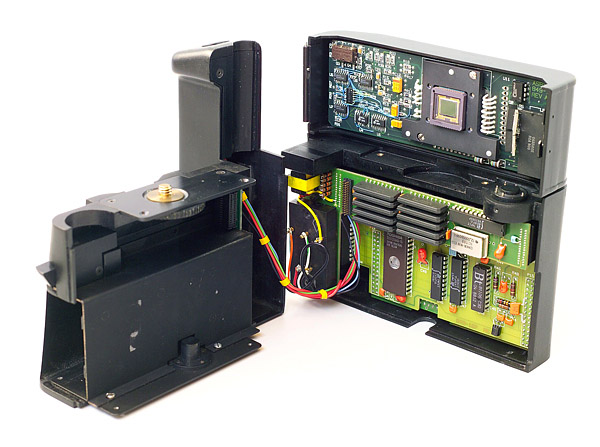
In 1990 , Kodak engineers further improved the Hawkeye II , added a film winding motor (see the photo below), and moved a lot of equipment out of the camera body and into the camera bag box .
The following images are Kodak Hawkeye II (1990). The images are from Mr. James McGarvey.
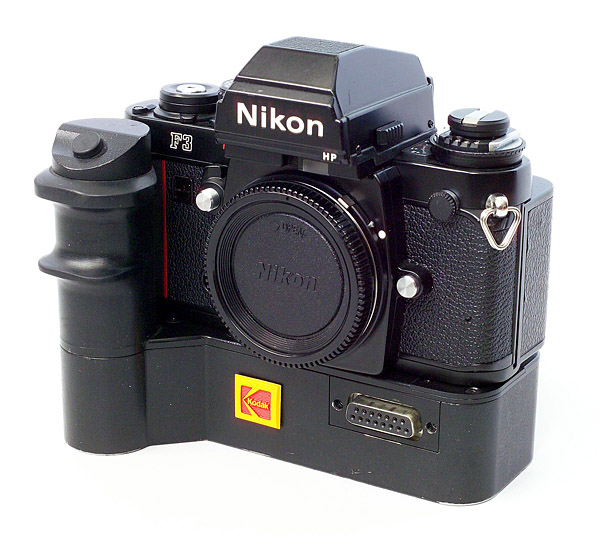
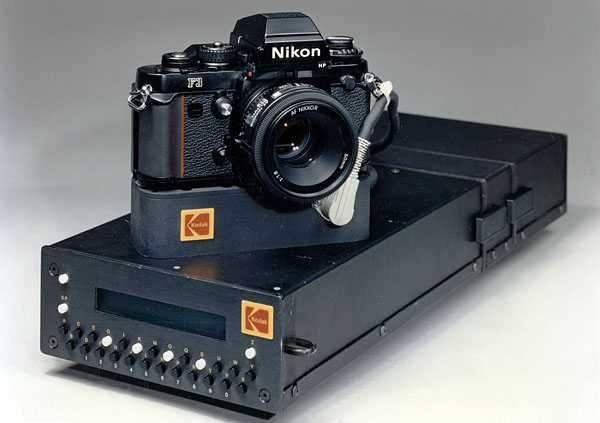
Kodak repackaged the Hawkeye II under the Kodak Professional DCS ( Digital Camera System ) name and marketed it in May 1991. This was the first DSLR to actually go on the market ( photo below ) . In terms of resolution, the Electro-Optic Camera in 1988 was 1320x1035 ( 1.4MP ), the Hawkeye II in 1989 and the Professional DCS launched in 1991 were 1280x1024 ( 1.3MP ), and the Nikon N8008s/F-801s autofocus mechanism was used in 1992 The next generation Professional DCS 200 increased to 1524x1012 ( 1.5MP ), and to 1995 Professional DCS 460 increased to 3060x2036 ( 6.2MP ). Kodak has also produced several medium-format camera backs, and the photosensitive chips of Leica M8 and M9 are also Kodak products. Perhaps because the next generation model is Kodak Professional DCS 200 , many documents write Kodak Professional DCS as Kodak Professional DCS-100 , but the camera body in the photo only has the word DCS instead of DCS-100 , so DCS-100 may be a rumor, because Kodak did not make cameras of this type. For convenience, Kodak Professional DCS is referred to as Kodak DCS for short .
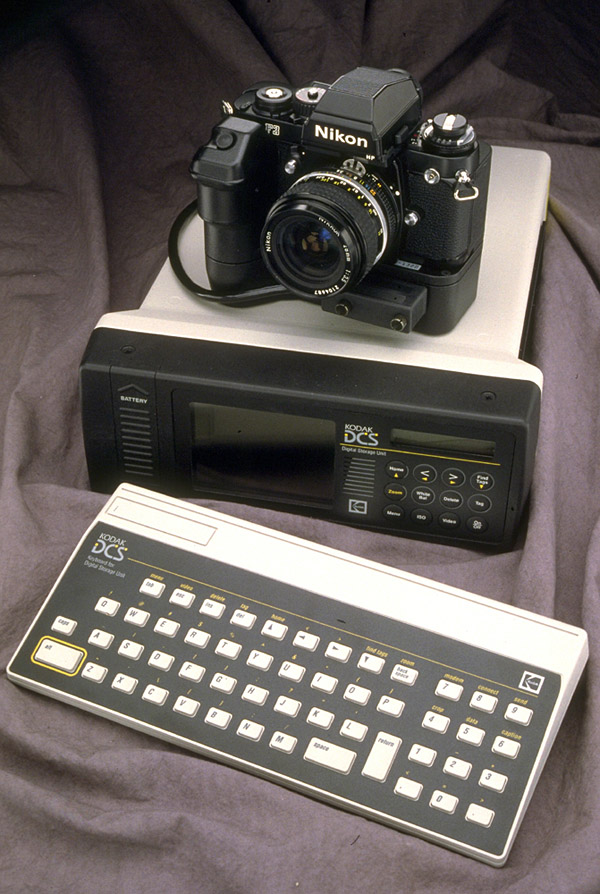
I have had a complete Kodak DCS; but due to some reason I misplaced the motor and the tethered case. I will have another post if I could find them in the near future.
Kodak DCS 200
Kodak released the Kodak DCS 200 on August 6 , 1992 , just over a year after introducing the Kodak DCS . DCS 200 uses Nikon F801/N80008 body , and later changed to Nikon F801s/N8008s . Why did Kodak choose N8008? There is a saying that it is because N8008 is the only mid-level model among Nikon SLRs that can change the camera back; why is it the mid-level model of Nikon ? Because the Kodak DCS 200 was originally intended to be a lower-priced model, the top-of-the-line Nikon F4 was too expensive.
Kodak produced a base like a winder for the N8008 , which has a built-in 80MB hard disk and uses AA batteries. The back of the base is extended to install the photosensitive chip and electronic circuits. It replaces the back of the N8008 . So from a certain point of view, the Kodak DCS 200 is equivalent to adding a digital camera back to the Nikon F801/N8008 (see photo below).
The following images are the Kodak Professional DCS 200 (1992):

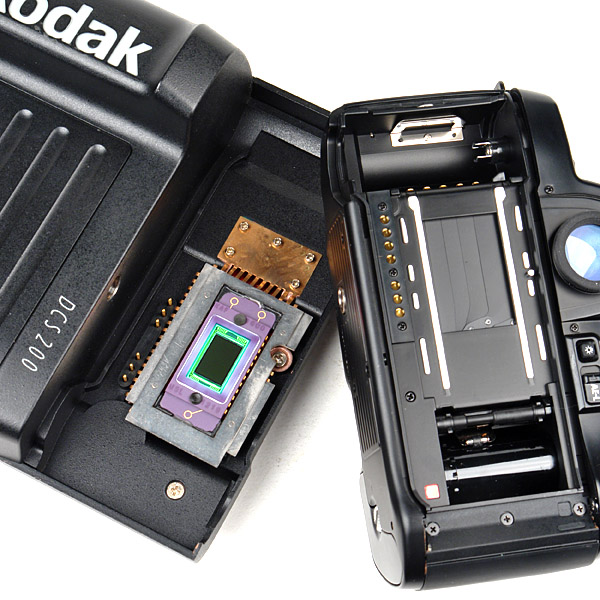
The resolution and format of the DCS 200 photosensitive chip are 1524x1012 and 14x9.3mm (smaller than the 4/3 system), and the crop factor relative to FF is 2.57 , so a FF 50mm standard lens on the DCS 200 The angle of view on the camera is equivalent to 128.7mm in 135 format , so it is very common to pair the DCS 200 with Nikon AF-D 20mm f/2.8 . The photos taken are stored in the built-in hard disk of the base. Because there is no LCD on the back of the machine , the user has to transfer the photos to a computer through the SCSI interface and use the software provided by Kodak to view them. It should be noted that the JPEG format had not yet appeared in 1992 , and Kodak used a unique TIFF format that was not recognized by general image processing software, so Kodak only provided software can be displayed or converted into standard TIFF format. Kodak DCS 200 is a DSLR that Kodak tries to produce at a lower cost . The main target is the desktop publishing industry, so the production volume is not very large, and it is not common in the second-hand market. Plus, the Kodak DCS 200 was the first DSLR with autofocus in history .
Kodak DCS 4xx
Then, Kodak cooperated with the Associated Press ( AP for short ) and launched the AP NC2000 model using the Nikon F90/N90 body in February 1994. This is a camera designed for news photography of the Associated Press newspaper. And the format is 1268x1012 ( 1.3 MP ) and 20.5x16.4mm respectively , relative to the crop factor of 135 format is 1.65 , the photosensitive chip is slightly smaller than the Canon APS-C model.
In August of the same year ( 1994 ) , Kodak launched Kodak DCS 420 , which uses a photosensitive chip smaller than AP NC2000 . The resolution and format are 1524x1012 ( 1.5 MP ) and 13.8x9.2mm , respectively , relative to the crop factor of 135 is 2.6 . Then in March 1995 , Kodak DCS 460 appeared, which uses APS-H photosensitive chip with a format of 27.6x18.4mm , a resolution of 3060x2036 ( 6MP ) , and a crop factor of 1.3 relative to the 135 format , and Canon The EOS 1D released in 2001 is similar, so Kodak DCS 460 is the first one to useAPS-H format, 6 MP resolution model. In addition to DCS 420 and DCS 460 , there is also Kodak DCS 410 ( 1996 ) , which uses the same chip as DCS 420 , but it is a simplification of DCS 420 in terms of specifications.
Kodak DCS 4xx all use Nikon N90/F90 body. Nikon launched N90/F90 in 1992 , which is the time when Kodak launched DCS 200 , so Kodak can only use N8008/F801 , so when DCS 420 was launched in 1994 , N90/F90 was available. Nikon launched an improved version of the N90s/F90x in 1994 , and naturally Kodak would follow suit. Due to the schedule of Nikon changing the fuselage, a small number of DCS 420 and DCS 460 in the early days used N90/F90 , and later changed to N90s/F90x .
The first photo below is of a Kodak DCS 410 using a Nikon N90s/F90x body . The second picture is DCS 420 , and the third picture is the back of DCS 420 with photosensitive chip on it . The battery and PCMCIA memory card slot are in the base, and the back of the machine is connected to the fuselage with thin red wires. The fourth one is Kodak DCS 460. It is difficult to distinguish 420 and 460 from the appearance alone , but you must look at the mark on the base. DCS 410 is easier to recognize, because the Kodak lettering on the handle is red, DCS 420 and DCS 460 are white; from Kodak DCS 410 ( 1996 ) , the Kodak lettering in the Kodak Professional logo is red.
The next few images are the Kodak Professional DCS 410 (1996), DCS 420 (1994) and DCS 460 (1995):

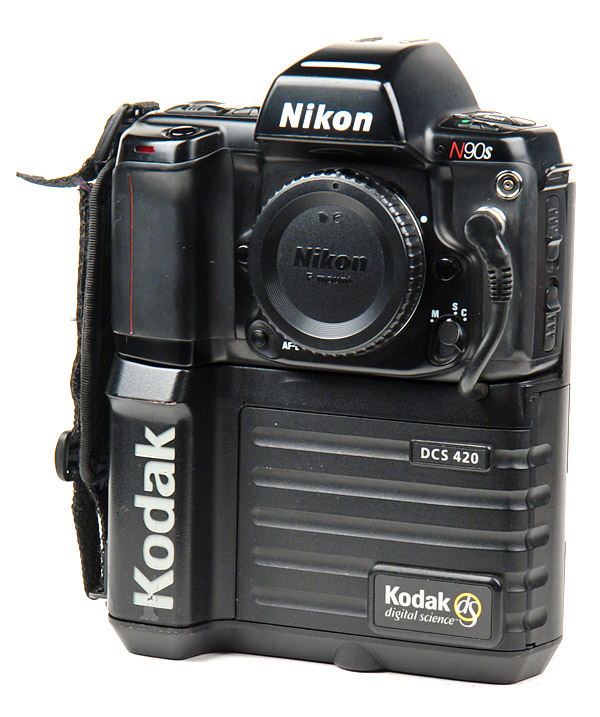
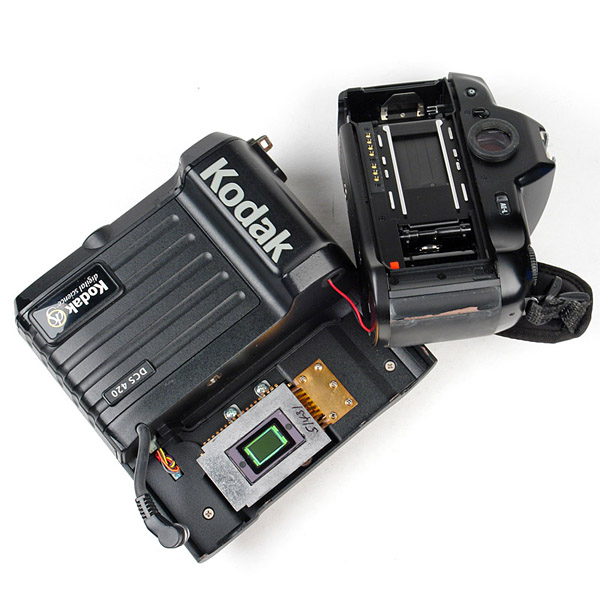
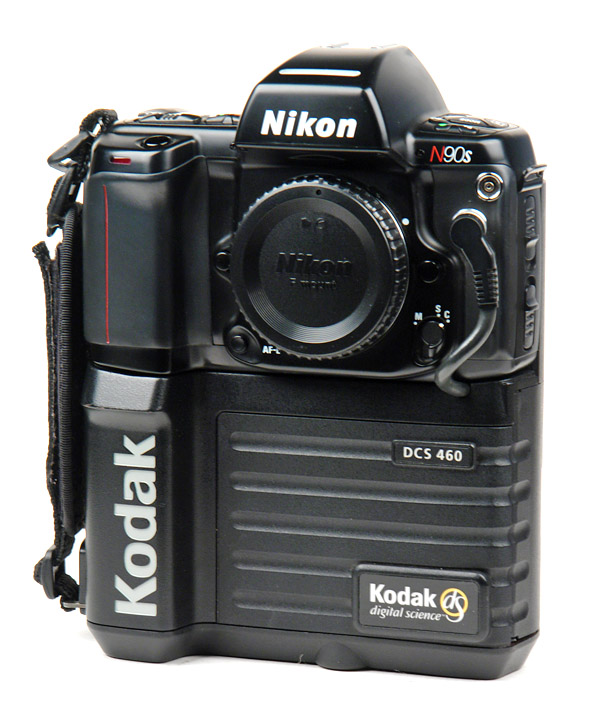
Kodak EOS-DCS x
After the launch of DCS 460 , Kodak turned to cooperate with Canon . Since 1995 , Kodak has launched three new models with the Canon EOS 1 N body: Kodak EOS-DCS 5 ( March 1995 , format 13.8x9.2mm- crop factor 2.6 , resolution 1524x1012 is the same as DCS 420 ), EOS-DCS 3 ( July 1995 , format 20.5x16.4mm- crop factor 1.65 , resolution 1268x1012 ) and EOS - DCS 1 ( December 1995 , format 27.6x18.4mmAPS-H - crop factor 1.3 , resolution 3060x2936 - same as DCS 460 ).
The photo below is of Kodak EOS-DCS 1 ( 6MP ). Its structure is the same as that of the DCS 420. The bottom of the fuselage is still a base for installing batteries and PCMCIA memory cards, and the top of the base is the back of the photosensitive chip. From DCS 200 's back-type structure to the end of EOS DCS series, due to the further cooperation between Kodak and camera suppliers ( Canon and Nikon ), the integration of each model is relatively high, and it is no longer the body and the camera. The way the back is separated, but there is a sense of a complete camera, the machine seems to have the prototype of today's DSLR .
The following is a Kodak Professional EOS-DCS 1 (1995)
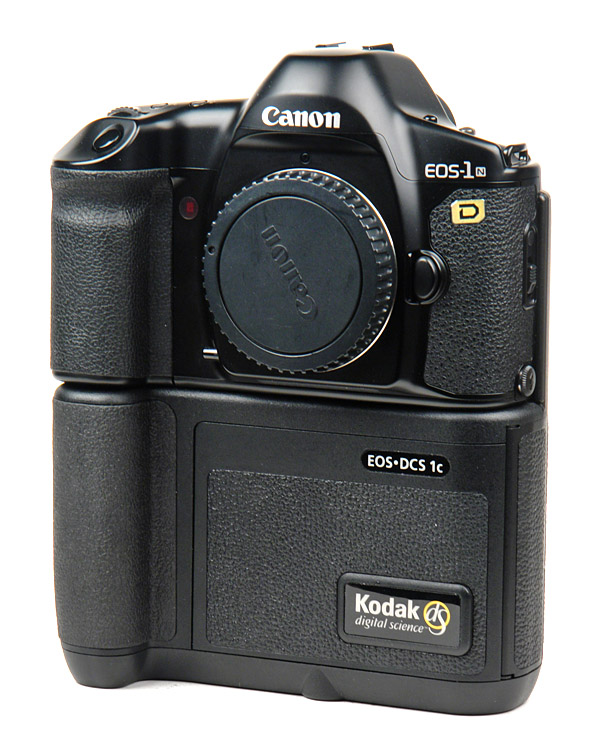
Hope this helps. Will post Part II a couple of days later.
CK
